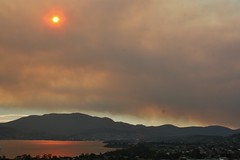 |
| Tasmanian Bushfires (Photo: James975) |
This week the Tasmanian government released its inquiry into the January 2013 bushfires that destroyed numerous properties on the Tasmanian Peninsula.
A key finding is that modelling predicted fires would reach the town 24-hours before it occurred, but this modelling wasn’t disclosed quickly enough.
But putting excessive faith in bushfire modelling is a mistake, particularly as models are not yet sophisticated enough to ensure accurate warnings.
Bushfires across the island had enormous impact on Tasmania: through extensive property damage and harm to the economic, social and psychological well being of affected communities. So a thorough investigation into the causes and consequences of these fires is to be welcomed.
But the bushfire inquiry’s report and the subsequent media reportage has spread a dangerous idea - that government can provide a very high level and reliable community protection from bushfire threats with bushfire models.
Indeed, a powerful storyline in the report is that the Tasmania Fire Service failed to adequately warn communities of the immediate risk of the fires, by not disclosing findings of a predictive model quickly enough.
However, careful reading of the inquiry report undermines this simplistic interpretation about fire models, and glosses over some very serious operational issues concerning the use of bushfire predictions.
The basis for the finding is a match between the actual extent of the Dunalley fire and a 24-hour prediction of the fire spread using an Australian designed bushfire model. But one accurate prediction doesn’t mean we should trust models every bushfire season.
The inquiry acknowledged that fire behaviour is influenced by numerous local factors. These include terrain, fuel loading, fuel type and moisture, and variation in vegetation and winds. Under some conditions severe fires can also create their own weather.
These factors are not perfectly captured in the current generation of predictive fire models, and in any case, the appropriate data are not always available.
The sole expert witness Dr Jon Marsden-Smedley of the University of Tamania to the inquiry - who gave evidence about fire behaviour modelling - stated that the current generation of predictive fire models are imperfect, and are based on generalized meteorological data rather that local measurements.
He also stressed that fire predictions are susceptible to the effects of atmospheric instability that are not represented in the models yet.
Despite the expert advice, the inquiry found that the modelling from January 3, which predicted the town of Dunalley was at risk, should have been acted upon immediately by the Tasmania Fire Service.
The big concern is that such literal application of modelling will lead to “warning fatigue”. Given the limitations of the models there will be numerous false alarms, and there will be some inevitable failures to predict extreme fires. Over time people will become disconnected from fire warnings.
This is a real concern. On the morning of January 4 local communities were clearly warned that a severe fire situation had developed but many people failed to comprehend what these warnings meant, resulting in significant risks to life.
Better is to use the hard won field experience of fire fighters and rural landowners. Local expertise and field experience are critical for assessing fire risk.
Indeed, one of the recommendations of the inquiry is that the Tasmanian Fire Service should place greater reliance on local knowledge from rural landowners. Putting the emphasis on modelling can take this vital knowledge away.
A key organising principle to the inquiry is that the Tasmanian government is duty bound to provide safety and certainty for citizens. The notion that models can provide perfectly reliable advance warning of threat is an appealing idea.
But this can lead to a dangerous thinking with increasing dependence on the state to eliminate fire risk, including an unrealistic expectation of advanced warnings.
Failure to achieve this ideal invites blame, litigation and more fundamentally, people not accepting the responsibilities associated with living in inherently flammable landscapes.
David Bowman receives funding from ARC, NERP, TERN, and NASA.
This article was originally published at The Conversation. Read the original article.

No comments:
Post a Comment